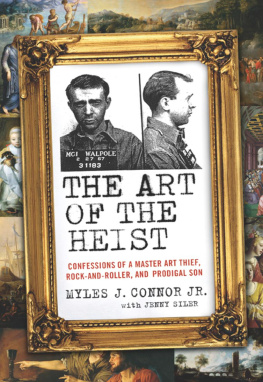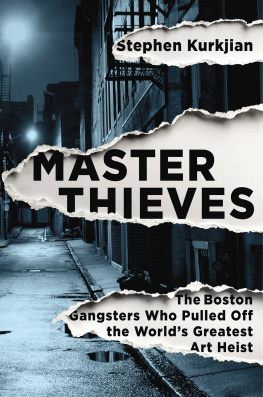The Art of the Heist
Confessions of a Master Art Thief, Rock-and-Roller, and Prodigal Son
Myles J. Connor & Jenny Siler

To my parents, Myles and Lucy
Connor, and my children Myles
J. Connor III, Kim Connor Tierney, and
my granddaughter, Taylor. Also in loving
memory of my granddaughter, Nicole.
And to my family and friends,
especially Suzanne King.
Special acknowledgment to Martin K. Leppo, truly one of the best trial lawyers in America, and my friend for more than thirty years. Marty has contributed so much to this book that without him, it could not have been written.
Myles J. Connor Jr.
Contents
On March 18, 1990, shortly after 1:00 A.M., two men
The feeling of being alone in an empty museum is
It was the adrenaline rush of art and theft that
As the summer of 1965 drew to a close I
The outcome of my dramatic escape from the Hancock County
Over the winter of 196566, working on a series of
I owe my life to the extraordinary staff at Massachusetts
On February 27, 1967, I was transferred from the Charles
Youve already heard me confess that Im not a particularly
Not long after the rape conviction was overturned I was
I faced a choice: still wild, or tame? I applied
If rock and roll was easy money, the Dedham job
Given the complex trajectory of my life, its difficult to
As my profits from the bank robberies grew, collecting came
Like all good businessmen, I knew the importance of diversifying
In the spring of 1974 Bobby Donati came to me
My first phone call from the jail was to Ralph
Ive always wondered what those old fogies on the parole
Even with Santos sloppy mistake, it appeared as if the
That two unidentified men walked into the Museum of Fine
Now that the Rembrandt was in my possession, I had
Much to my dismay, I soon found myself back at
Friday, January 2, 1976, dawned bright and early at the
On January 5, 1976, my parole was formally revoked and
I can truthfully say that there arent many things in
Because Marty Leppo represented Tommy Sperrazza and others who were
On February 1, 1981, jury selection began in the Spinney-Webster
The Spinney-Webster convictions devastated me. I returned to Walpole in
In late August 1984 Earle Cooley came to see me
Throughout both murder trials, the intervening four and a half
Its difficult to put an exact value on a collection
O n March 18, 1990, shortly after 1:00 A.M. , two men dressed in police uniforms and wearing false mustaches knocked on a side door of Bostons Isabella Stewart Gardner Museum. The night was typical of early spring in New England: foggy, with more than a bit of chill in the air. Around the city known for its Irish heart, St. Patricks Day festivities were just winding downin fact, revelers who were leaving a nearby party would later recall having seen the two men sitting in an unmarked car near the museums side entrance. But for the pair waiting outside the Gardner Museum, the party was just beginning. After convincing one of the two night security guards to let them inside, the counterfeit cops quickly forced both guards down into the basement, where they duct-taped the men to support posts.
For the next hour the thieves roamed the museum unimpeded. Once in the galleries, they proceeded to unceremoniously slash priceless canvases from their frames. Though their methods were brutish, the men showed no small amount of expertise in their selection. Among the items they chose were The Storm on the Sea of Galilee, the only seascape Rembrandt is known to have painted; The Concert, a Vermeer masterpiece and one of only some thirty-five known paintings attributed to the Dutchman; Manets Chez Tortoni; and five Degas drawings. They also took a Shang Dynasty bronze beaker and, in a gesture that has never ceased to puzzle investigators, the bronze finial from a Napoleonic flagstaff.
By 3:00 A.M. the thieves were gone, but not before they had removed the videotape from the museums security cameras and ripped the computer printout from the motion detectors. The FBI, which soon took charge of the case, would call the heist the costliest of its kind in U.S. history. Estimates put the monetary value of the pieces taken that night at upward of $300 million. The cultural value of the masterworks, especially the one-of-a-kind Rembrandt seascape and the rare Vermeer, is, by all accounts, inestimable.
From the beginning the case proved dauntingly difficult to crack. The thieves may have been sloppy in their methods, but they left behind not a trace of evidence as to their identities. The theft of fine art differs from other crimes in that the passage of time can make these cases easier to solve rather than more difficult. Stolen artwork often surfaces years or even decades after the fact, as key players die, statutes of limitations expire, or pieces change hands. But after almost two decades, and despite a $5 million reward and global efforts to track down the missing Gardner Museum art, not a single item taken that night has been recovered.
I n all that time, one name has surfaced again and again in connection with the robbery: Myles Connor.
A hometown art thief with a genius IQ and a flair for the dramatic, Connor was the man authorities immediately suspected when they were called to the Gardner Museum on the morning of March 18. When it came to museum robberies, Connor had a resume a mile long, including the 1975 theft of a Rembrandt from Bostons Museum of Fine Arts nearby. Almost every aspect of the Gardner heist carried Connors fingerprints: the brazenness with which the theft had been carried out; the sophistication shown in the pieces chosen; even the police uniforms, which were a form of disguise Connor and his associates had used in the past.
There was only one problem with this theory: at the time of the Gardner heist, Connor was in federal custody in Illinois. Still, so strong was the FBIs suspicion that Connor was somehow involved that one of the first actions they took was to place a call to the superintendent of the jail where Connor was being held, asking him to confirm that Connor, who had a history of daring prison escapes, was still in his cell. He was.
When questioned about his involvement in the theft, Connors reply was impudent. Youd have known if it was me. I would have taken the Titian, he said, referring to one of the centerpieces of the Gardner Museums collection, a large oil painting depicting the rape of Europa.
Despite his airtight alibi, Connor was and remains a prime suspect in the Gardner theft. The FBI and others claim he masterminded the heist from his prison cell, hoping to use some of the artwork as a bargaining chip to reduce his federal sentence. As with so much else in the murky world of art and antiquities theft, the truth about Connors involvement in the events of that March evening is much more complicated than anyone might have guessed.
This account will not neatly resolve this particular case. It will show how the son of an honest cop grew up to become the countrys most notorious art thief, one who is still a prime suspect in the Gardner theft. But there is more to Connors story than the unraveling of that particular mystery. Over the course of a long career in crime, Myles Connors passion for fine art slowly merged with his love of misadventure. He grew from a petty thief to a gun-and drug-runner, violent outlaw, and eventually art thief.
Like any true story, it is not always a pretty one. Yet Connors charm is evident. He is a rogue at heart, a man who inspires fierce loyalty and even love in those who know him wellnot through intimidation, but through the sheer force of his personality.







